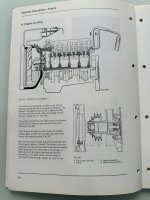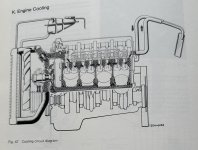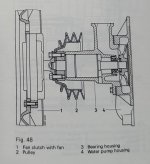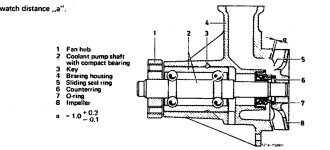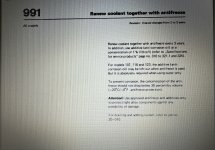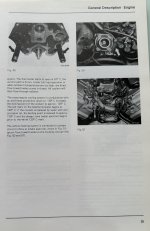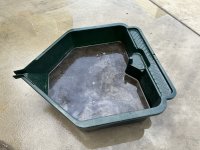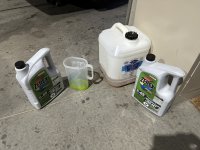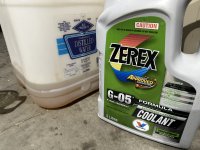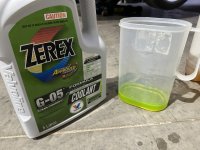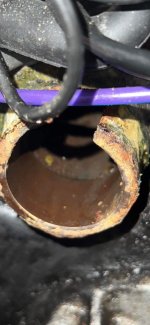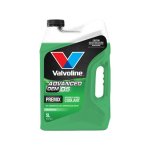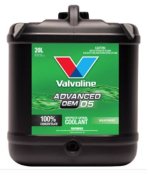So here's a process I've developed to change your coolant, which can be adapted to almost any vehicle. Follow this procedure on a COLD engine:
- Place the vehicle on jack stands so it’s relatively level,
- Remove the radiator cap,
- Place a 15-20L container under the bottom radiator hose,
- Loosen the top and bottom radiator hose clamps at the radiator,
- Rotate slightly and pull the bottom hose from the radiator (stay clear of the draining coolant),
Note: Using only the drain plug on the radiator (if fitted) is not sufficient since it does not provide the water flow required for an effective flush.
- Disconnect the top hose at the radiator in a similar way to the bottom hose,
- Disconnect the heater hose at the heater tap (usually located at the back and top of the engine),
Note: Disconnecting both heater hoses is ideal, however access issues can make this too difficult or ineffective. Generally MB heater taps are open when the engine is off and there is no need to remove the thermostat using my method.
Remove the coolant drain plugs from the block (if fitted) and drain the old coolant into the waste container,
Note: If the drain plugs have never been touched, then it may be wise to leave this step until next time. They may be corroded into place and attempting to loosen them now could lead to drain plug damage where the only fix is engine removal!
- Remove the waste container from under the car,
- Put a large container (or several) under the radiator, expansion tank and back of the engine; otherwise you’re about to make a huge mess!
Note: I once cut down a 1000L plastic water tank for this purpose, but it did become rather hard to move when it was full of water! Don’t even bother trying an inflatable children’s wading pool; it won’t last long when you drag it across the garage floor!
- Fit a high flow nozzle to a garden hose,
- Blast mains pressure water into the radiator expansion tank, radiator top neck and heater hoses (in both directions) until the water comes out clean,
- Reconnect the bottom radiator hose without tightening the clamp, just enough to hold water,
Note: if you push the hose on too far, you’ll be making the job more difficult since you’ll be removing and refitting it several times during this process.
- Refit the block drain plugs only enough to stop water escaping,
- Rapidly fill the cooling system with water via the expansion tank until water runs out the radiator top neck or heater hoses,
- Disconnect the bottom hose and allow the water to rush out quickly (the large volume of water rushing out will eventually clean the insides nicely),
- Repeat the process of refilling and draining as many times as necessary until the water comes out clean,
- Alternate filling the system between the expansion tank, heater hoses and radiator top neck until clean water is consistently coming out the bottom hose,
Note: Compressed air can be introduced to the water flow (with care) if water pressure in your area is relatively low and your cooling system is in poor condition where mild blockages have been identified.
Direct the water in both directions; through the disconnected heater hose and through the heater tap,
Note: If you’ve managed to disconnect both heater hoses, then you can flush the heater core in both directions and also through the engine and out the bottom hose on both sides.
Continue flushing in both directions (where possible) until all debris is flushed out & only fresh water is visible.
Note: If you find there’s no water coming out from an area you’re trying to flush, you can block water leakage elsewhere with your hands (or other means) to force a backflow, or to increase the pressure where necessary. If there’s no flow no matter how hard you try, you may have a serious blockage which requires the removal of various components to rectify.
Remove the block drain plugs,
Note: Clean the threads with a wire wheel as necessary and replace them if badly corroded.
If you’re confident you can do so without damage, carefully use compressed air to blow out any remaining fresh water from the heater core,
Note: Not doing this step will mean the new coolant will be slightly diluted.
- Refit the block drain plugs with new washers (do not over-tighten them),
- Replace rubber hoses where necessary (unusually soft/hard, or damaged),
- Replace all the hose clamps with ‘Wurth’ brand ‘Zebra’ type or similar design,
Note: Good quality hose clamps won't damage the hoses and will allow the clamp/hose to be removed and refitted many times if necessary in the future. I would definitely NOT recommend using any hose clamp with slots cut from the band, which will bite into the hose and affect its integrity.
- Position the hose clamps for easy access and reconnect all the hoses,
- Tighten the hose clamps using a Wurth hose clamp tool or 7mm socket on a 1/4” drive,
- Decant some of your commercial or DIY premix into a 2L container (not a drink container) and using a funnel, refill the cooling system to a level half-way between minimum and maximum on the expansion tank,
- Start the engine with the radiator cap removed, heater on hot and the heater fan on low,
- Monitor the coolant level and top up when necessary using your premix,
- Position the car on an exaggerated (but safe) incline with the radiator expansion tank as the highest point in the cooling system,
- Continue to run the engine and monitor the coolant level until the engine reaches normal operating temperature,
- Refit the radiator cap,
- Test drive a short distance, while keeping an eye on the engine temperature,
- Let the engine cool overnight and recheck the coolant level,
- Relax for 2-5 years!!!
As you can see it’s an involved process if it’s to be done correctly. You can see why I was exhausted just thinking about it and I ended up doing this 4 times just before leaving the factory! It’s well worth paying an expert to do all this if you don’t feel confident to DIY!
You can complete an even more thorough flush using citric acid. This additional work may only be necessary if your cooling system is heavily contaminated with debris, rust or oil (heaven forbid). I have yet to try this process, so I cannot state if it’s worth the effort, effective, or even safe for you, your engine, or the environment.
So how can you dispose of the old coolant?? Not an easy answer so I’ve discovered… Coolant generally contains ethylene glycol which has anti freeze, anti boil and corrosion inhibitors. It is a poison, so it must be kept away from children and animals - DO NOT DRINK!! Unfortunately it has a sweet smell and taste which makes it even more dangerous. Some manufacturers are now using bittering agents or propylene glycol which is apparently not as toxic to animals/humans. Used and degraded coolant is even worse than new coolant since it may contain heavy metals such as lead and chromium and can become acidic under certain conditions. Do not store new or used coolant in drinking containers and make sure the containers used are clearly labeled and kept out of reach by little hands.
Some say you can discard coolant into the sewerage via the laundry trough, or directly into the sewer access opening in the back yard. This means it heads to the sewage treatment plant, instead of into the storm water, creeks, rivers and eventually untreated into the ocean... Definitely NOT the storm water drains or onto the ground. If it gets into ground water then it’s not good for the environment. Waste water used during the flushing process might be ok to discard on the lawn, but keep it away from fruit trees, vegetables, herbs and plants used for consumption.
Of course not everything you read on the web is true, however other properties of coolant I’ve discovered on the web include:
- It will completely dissolve in water,
- Has a low to moderate toxicity to aquatic life,
- Ethylene glycol breaks down in air from 1.5 - 10 days and in water or soil in several days to a few weeks,
- It is a common de-icing agent for airport runways (which runs off into storm water drains).
I’ve been told discarding coolant with waste oil (sump/engine/transmission/cooking oil) will contaminate the lot and it makes it unsuitable for recycling, but others say it’s ok depending upon the collection agency!
After additional research, the best I can recommend is to keep it separate, clearly label it and check out this website for a household waste collection near you. Search for the link, ‘Detox YourHome’:
www.sustainability.vic.gov.au
Note that the site specifically states they can collect waste coolant/antifreeze. Unfortunately individual collections are not very frequent, so you may have to store it for a while, or travel a greater distance if you wish to dispose of it quickly.

